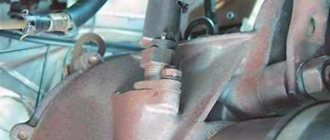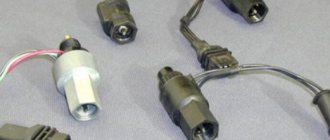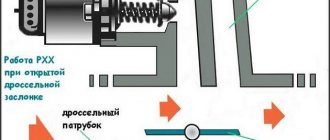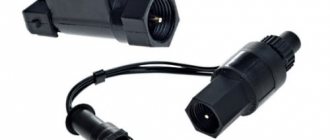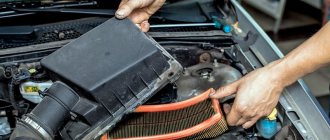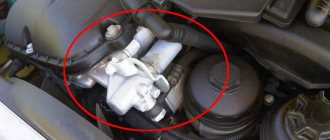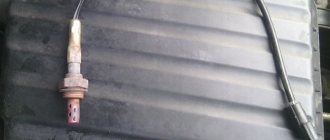Some car sensors and sensors only manifest themselves in the event of a breakdown. For example, the operation of the VAZ 2115 speed sensor is invisible during operation. Many drivers do not know that in addition to speedometer readings and mileage tracking, this device performs several more functions:
- Idle speed is adjusted even when the car is moving, based on speed readings;
- control of air supply bypassing the throttle assembly;
- When the throttle valve is closed, the engine control unit receives signals from the speed and crankshaft speed sensors.
Design and principle of operation
The sensor is a complex of mechanical and electronic components operating according to the Hall principle.
The rotating parts convert the electrical signal into a chain of pulses that are multiples of the rotation of the sensor axis. Due to the mechanical connection of the sensor rod with the wheel hub, the rotational movement of the wheel is converted into the distance traveled.
- when the outer surface of the tire rotates 360°, the wheel moves horizontally a certain distance;
- this path is equal to the circumference of the tire, it is programmed into the engine ECU;
Important: Installing wheels of a non-standard size disrupts the operation algorithm of the VAZ 2115 speed sensor.
- the corresponding block in the speedometer panel determines the distance traveled;
- the distance traveled divided by the time of movement is nothing more than speed.
Both of these parameters are involved in the coordinated operation of the engine's electronic control unit.
How to check the speed sensor yourself
Among the main ways to check DSA are:
- checking with a voltmeter;
- diagnostics using a control lamp;
Many cars have a sensor whose operation is based on the Hall effect. It is not difficult to check this type of DSA. However, there are other types of speed sensors: reed sensor, as well as inductive speed sensor. The method for testing such sensors is somewhat different.
Checking the speed sensor with a multimeter
The most common type of speed sensor has 3 contacts: pulse, ground and voltage. First of all, you need to determine the presence of grounding and 12V voltage on the contacts.
These contacts are checked with a multimeter, while the “pulse” contact is checked by rotating. Normally, the voltage between the pin and ground should be from 0.5V to 10V.
To check the speed sensor with a voltmeter you will need:
- remove the speed sensor;
- determine the purpose of contacts;
- switch the multimeter to voltmeter mode;
- connect the incoming contact to the output;
- ground the second contact to the engine (can be to the car body);
Then the speed sensor must be rotated, determining the presence or absence of signals in the work cycle. The output voltage of the sensor is also measured. To do this, it is recommended to put a piece of tube on the sensor axis and rotate it at a low speed of up to 5 km/h. The faster the sensor rotates, the higher the voltage on the voltmeter should be.
How to check the speedometer sensor without removing it
If the owner does not know how to remove the speed sensor from the car or intends to do a quick check, you can do without removing the sensor. For such a check you will need:
- raise the car on a jack so that one drive wheel comes off the ground and rotates freely;
- Next, the sensor contacts are connected to a voltmeter. Then you need to rotate the wheel and determine whether voltage appears, and whether there is a change in frequency;
If the voltage is fixed and the frequency changes, the speed sensor is working. In the case when there is no voltage, there is a high probability of failure of this element.
Quick check of the speedometer sensor with a test light
Checking the speed sensor can also be done using a warning light (or so-called control light). As part of such a check:
- The pulse wire is disconnected from the sensor;
- the car is lifted on a jack;
- one wheel is hung out and the ignition is turned on;
- then one control wire is powered to the “+” battery;
- the second wire will be connected to the “signal” connector;
If the light blinks while the wheel is rotating, the speed sensor is working. If the lamp does not blink, it will indicate that the sensor is faulty and requires replacement.
What happens if this sensor breaks?
Of course, the car will not stall, and you can continue driving it, but only to the place of repair.
Signs of malfunction:
- Absence or incorrect readings of the actual vehicle speed. The speedometer needle “hangs” at one mark, moves chaotically, or does not deviate from “zero” at all.
- On a moving vehicle, when the accelerator is released, interruptions in idle operation are observed.
- Floating idle speed when stopping.
- Unreasonably high fuel consumption.
- During intense acceleration, dips in traction occur: there is no increase in power in proportion to pressing the gas.
Speed sensor - signs of malfunction
During operation of a car of absolutely any brand, some parts can break, sometimes this happens with the speed controller. Problems with it on the fifteenth VAZ model are not a very common breakdown, but it can still happen from time to time.
The trip computer can indicate a malfunction of the speed sensor by generating error codes:
- Code P0500 - indicates that no data is being received from the speed sensor;
- Code P0503 means that the signals are interrupted.
Other signs may also indicate the above problem:
- Unstable operation with subsequent breakdown of the speedometer. It all starts with the needle on the dial twitching chaotically.
- Reduced engine power.
- Fuel consumption is too high.
- Changing the engine speed.
Of course, the above problems can indicate not only problems with the speed sensor, but, as experts say, in these situations it is checked first.
Where is the speed sensor located and why does it break?
The sensor is located on the gearbox housing, in its upper part. To get to it, you need to lift the car on a lift, or use the inspection hole.
The device and its electrical wiring are affected by moisture, road reagents and temperature changes. The causes of the malfunction are the following:
- breakage of connecting wires;
- corrosion of the connector terminal block;
- mechanical failure of the rotating rod;
- failure of the electrical part.
The symptoms of any of the breakdowns are the same; the sensor itself cannot be repaired: only replaced. Only oxidized contacts or broken wiring can be restored.
Features of replacing the speed sensor on VAZ-2113, 2114, 2115
The main role of the speed sensor (DS) is to obtain information about the number of revolutions transmitted from the gearbox gears to the front wheels of the car, as well as transmitting this data to the electronic control unit (ECU).
The controller processes the received information and transmits it to the control panel, thereby informing the driver about the speed of movement and the distance traveled. In addition, based on the same information, the ECU calculates the required proportions for the fuel mixture supplied to the engine cylinders.
There may be two types of speed sensors in VAZ 2114 cars:
- a sensor with a mechanical drive from the gearbox gear and a cable drive of the speedometer (has a side outlet for wires and a seat for the cable);
- sensor with mechanical drive from the gearbox and electronic connection to the controller;
The speed sensor is located on the rear of the engine on top of the gearbox housing.
Malfunctions
Signs of a broken DS are:
- incorrect speedometer readings (chaotic needle movement);
- problems with the engine idling;
- error message (code 0500, 0501);
- “floating” speed;
- “failures” during acceleration;
- increased fuel consumption.
DS malfunctions include:
- lack of contact in the connector;
- sensor wiring break;
- breakdown of the mechanical drive of the sensor;
- failure of the sensitive element (for electronic DS).
After checking the contacts and wiring and making sure that everything is in order, you need to remove the sensor from its seat and replace it with a new one. If the sensor is not replaced, the ECU will “force” the engine to operate in emergency mode, which will lead to increased fuel consumption, as well as wear and tear on other elements of the fuel system.
The speed sensor itself is inexpensive: mechanical versions cost 300-500 rubles. Replacing it at a service station will cost approximately 200-300 rubles.
However, it is not necessary to overpay for the work. The speed sensor can be easily replaced independently in 15-20 minutes.
When purchasing a DS, you need to pay attention to its manufacturer and the material used to make the rod. A rod made of plastic may fail after just a few days. By the way, if the rod falls apart, you will have to disassemble the gearbox.
Self-replacement of the sensor
- Raise the hood and turn off the power by removing the ground terminal from the battery.
- For ease of operation, remove the air duct corrugation.
- When access to the sensor is open, disconnect the wires from it.
- Turn the sensor body counterclockwise by hand and unscrew it.
- If you suspect a malfunction of the drive, unscrew the nut securing it with a 10mm wrench and pry off the drive housing with a slotted screwdriver.
- Carefully remove the drive.
- Install the new drive and secure it.
- Install the new sensor and connect the wires.
Conclusion
After replacing the sensor, start the engine and check its operation, first at idle, and then while driving. Pay attention to the speedometer, odometer, and how the engine reacts to sudden acceleration. If the signs of a malfunction have disappeared, then you have correctly identified their cause.
How to check
First of all, we carry out a visual inspection. The wires must be intact and have no obvious kinks or damage to the insulation. The cleanliness of the contacts on the connector is also checked. After inspection, we check the electrical part of the device.
- You can jack up one of the front wheels of the car and spin it with the ignition on (we don’t start the engine). Voltage surges are checked using a multimeter at the information contact (central terminal).
- If you remove the sensor, you need a device to force the rod to rotate. A voltage of 12 volts is supplied to the power terminals, the tester is connected to the negative terminal and the signal contact. When rotating, we register impulses. If they are not there, the sensor needs to be changed.
To replace, you will need a 21 key. We replace the faulty part with the negative terminal of the battery reset.
Advice: You should not save money by buying a cheap sensor from a dubious manufacturer. A branded part is not so expensive that you risk a breakdown on the road, where there will be no way to diagnose and replace the speed sensor.
Causes of failure of the VAZ 2115 speed sensor
Reasons that can be immediately identified or found out only with the help of a thorough diagnosis may be the following:
- The regulator's electrical circuit may break.
- The device loses contact with the on-board network.
- A mechanical drive malfunction is detected.
- The sensor may simply become damaged or worn out.
View this post on Instagram
Posted by Russfit (@russfit.moscow) Sep 4, 2021 at 3:57 PDT
Diagnostics of sensor operation
You can carry out diagnostics using a multimeter by first dismantling the controller:
- Next, you need to make certain settings for the tester so that it works with alternating voltage.
- Then you need to close the probes of the measuring device to the contacts. The first probe must be connected to the contact from the dashboard, and the second to the part in the area of the car body.
- There is a rod at the front of the controller; when it rotates, it means the device is turned on. For effective diagnostics, you need to rotate this rod.
- If the rod displays that there are no surges, then the controller is faulty.
